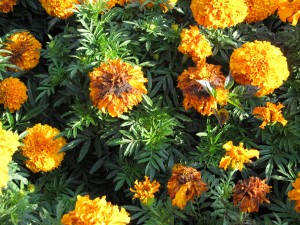Marigolds (Tagetes spp.) have been long time favorite summer annuals in Southern Appalachian gardens (USDA zones 6 and 7). Marigolds come in three sizes: 18-36 inch tall “African” marigolds, 12-18 inch medians and 8 -12 inch “French” border types and in two color choices- orange and yellow. Begin planting in April or May after frost danger has passed. Figure in a six week period for establishment and marigolds possess exceptional drought and heat tolerance over the summer months.
Botrytis, also called “gray mold”, is a serious fungus disease. Flower petals turn brown and are often covered with gray, fuzzy masses. Brown target-like spots may also appear on the foliage.
Botrytis is most troublesome during periods of extended cloudy, humid, and wet weather conditions. Flowers may capture and hold water from rainfall and irrigation. Irrigation should be scheduled in the early morning hours. You should select marigold cultivars with flowers that shed and do not retain water droplets.
Sanitation or removing old (spent) and diseases flowers is key to reducing the spread of botrytis through the garden bed. Avoid wetting the flowers when watering and adequately space plants to promote good air circulation.
An alternative is to apply fungicide sprays as soon as disease symptoms appear. Among the pesticides registered for use are Chipco 26019® (iprodione), Daconil® (chlorothalonil), and either Cleary’s 3336® or Domain FL® (thiophanate-methyl).


 Posted in
Posted in 
